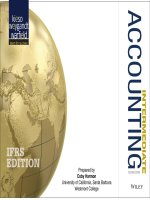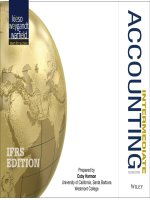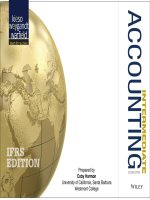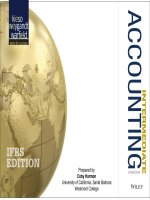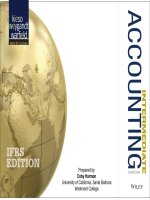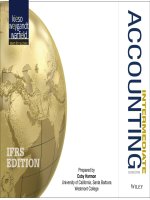Lecture Intermediate accounting (IFRS 2nd edition): Chapter 14 - Kieso, Weygandt, Warfield
Bạn đang xem bản rút gọn của tài liệu. Xem và tải ngay bản đầy đủ của tài liệu tại đây (1.83 MB, 94 trang )
14-1
PREVIEW OF CHAPTER
14
Intermediate Accounting
IFRS 2nd Edition
Kieso, Weygandt, and Warfield
14-2
14
NonCurrent Liabilities
LEARNING OBJECTIVES
After studying this chapter, you should be able to:
1. Describe the formal procedures
associated with issuing long
term debt.
2. Identify various types of bond issues.
3. Describe the accounting valuation for
bonds at date of issuance.
4. Apply the methods of bond discount
and premium amortization.
14-3
5. Explain the accounting for longterm
notes payable.
6. Describe the accounting for the
extinguishment of noncurrent liabilities.
7. Describe the accounting for the fair
value option.
8. Explain the reporting of offbalance
sheet financing arrangements.
9. Indicate how to present and analyze
noncurrent liabilities.
BONDS PAYABLE
Noncurrent liabilities (longterm debt) consist of an
expected outflow of resources arising from present obligations
that are not payable within a year or the operating cycle of
the company, whichever is longer.
Examples:
►Bonds payable
►Longterm notes payable
►Mortgages payable
►Pension liabilities
►Lease liabilities
Longterm debt has various
covenants or restrictions.
14-4
LO 1
Issuing Bonds
uBond contract known as a bond indenture.
uRepresents a promise to pay:
(1)
sum of money at designated maturity date, plus
(2)
periodic interest at a specified rate on the maturity
amount (face value).
uPaper certificate, typically a €1,000 face value.
uInterest payments usually made semiannually.
uUsed when the amount of capital needed is too large for one
lender to supply.
14-5
LO 1
14
NonCurrent Liabilities
LEARNING OBJECTIVES
After studying this chapter, you should be able to:
14-6
1. Describe the formal procedures
associated with issuing longterm debt.
5. Explain the accounting for longterm
notes payable.
2. Identify various types of bond
issues.
6. Describe the accounting for the
extinguishment of noncurrent liabilities.
3. Describe the accounting valuation for
bonds at date of issuance.
7. Describe the accounting for the fair
value option.
4. Apply the methods of bond discount
and premium amortization.
8. Explain the reporting of offbalance
sheet financing arrangements.
9. Indicate how to present and analyze
noncurrent liabilities.
Types and Ratings of Bonds
Common types found in practice:
uSecured and Unsecured (debenture) bonds.
uTerm, Serial, and Callable bonds.
uConvertible, CommodityBacked, DeepDiscount bonds.
uRegistered and Bearer (Coupon) bonds.
uIncome and Revenue bonds.
14-7
LO 2
Types and Ratings of Bonds
Corporate bond listing.
Company
Name
Price as a % of par
Interest rate based on price
Interest rate paid as
a % of par value
14-8
Creditworthiness
LO 2
14
NonCurrent Liabilities
LEARNING OBJECTIVES
After studying this chapter, you should be able to:
1. Describe the formal procedures
associated with issuing longterm debt.
5. Explain the accounting for longterm
notes payable.
2. Identify various types of bond issues.
6. Describe the accounting for the
extinguishment of noncurrent liabilities.
3. Describe the accounting
valuation for bonds at date of
issuance.
4. Apply the methods of bond discount
and premium amortization.
14-9
7. Describe the accounting for the fair
value option.
8. Explain the reporting of offbalance
sheet financing arrangements.
9. Indicate how to present and analyze
noncurrent liabilities.
Valuation of Bonds Payable
Issuance and marketing of bonds to the public:
uUsually takes weeks or months.
uIssuing company must
►Arrange for underwriters.
►Obtain regulatory approval of the bond issue,
undergo audits, and issue a prospectus.
►Have bond certificates printed.
14-10
LO 3
Valuation of Bonds Payable
Selling price of a bond issue is set by the
usupply and demand of buyers and sellers,
urelative risk,
umarket conditions, and
ustate of the economy.
Investment community values a bond at the present value of
its expected future cash flows, which consist of (1) interest and
(2) principal.
14-11
LO 3
Valuation of Bonds Payable
Interest Rate
uStated, coupon, or nominal rate = Rate written in the
terms of the bond indenture.
►Bond issuer sets this rate.
►Stated as a percentage of bond face value (par).
uMarket rate or effective yield = Rate that provides an
acceptable return commensurate with the issuer’s
risk.
►Rate of interest actually earned by the bondholders.
14-12
LO 3
Valuation of Bonds Payable
How do you calculate the amount of interest that is actually
paid to the bondholder each period?
(Stated rate x Face Value of the bond)
How do you calculate the amount of interest that is actually
recorded as interest expense by the issuer of the bonds?
(Market rate x Carrying Value of the bond)
14-13
LO 3
Valuation of Bonds Payable
Assume Stated Rate of 8%
Market Interest
14-14
Bonds Sold At
6%
Premium
8%
Par Value
10%
Discount
LO 3
Bonds Issued at Par
Illustration: Santos Company issues R$100,000 in bonds
dated January 1, 2015, due in five years with 9 percent interest
payable annually on January 1. At the time of issue, the market
rate for such bonds is 9 percent.
ILLUSTRATION 141
Time Diagram for Bonds
Issued at Par
14-15
LO 3
Bonds Issued at Par
ILLUSTRATION 141
Time Diagram for Bonds
Issued at Par
ILLUSTRATION 142
Present Value
Computation of
Bond Selling at Par
14-16
LO 3
Bonds Issued at Par
Journal entry on date of issue, Jan. 1, 2015.
Cash
100,000
Bonds payable
100,000
Journal entry to record accrued interest at Dec. 31, 2015.
Interest expense
9,000
Interest payable
9,000
Journal entry to record first payment on Jan. 1, 2016.
Interest payable
Cash
14-17
9,000
9,000
LO 3
Bonds Issued at a Discount
Illustration: Assuming now that Santos issues R$100,000
in bonds, due in five years with 9 percent interest payable
annually at yearend. At the time of issue, the market rate for
such bonds is 11 percent.
ILLUSTRATION 143
Time Diagram for Bonds
Issued at a Discount
14-18
LO 3
Bonds Issued at a Discount
ILLUSTRATION 143
Time Diagram for Bonds
Issued at a Discount
ILLUSTRATION 144
Present Value
Computation of
Bond Selling at
Discount
14-19
LO 3
Bonds Issued at a Discount
Journal entry on date of issue, Jan. 1, 2015.
Cash
92,608
Bonds payable
92,608
Journal entry to record accrued interest at Dec. 31, 2015.
Interest expense ($92,608 x 11%)
10,187
Interest payable
9,000
Bonds payable
1,187
Journal entry to record first payment on Jan. 1, 2016.
Interest payable
Cash
14-20
9,000
9,000
LO 3
Bonds Issued at a Discount
When bonds sell at less than face value:
►Investors demand a rate of interest higher than stated rate.
►Usually occurs because investors can earn a higher rate
on alternative investments of equal risk.
►Cannot change stated rate so investors refuse to pay face
value for the bonds.
►Investors receive interest at the stated rate computed on
the face value, but they actually earn at an effective
rate because they paid less than face value for the
bonds.
14-21
LO 3
14
NonCurrent Liabilities
LEARNING OBJECTIVES
After studying this chapter, you should be able to:
1. Describe the formal procedures
associated with issuing longterm debt.
5. Explain the accounting for longterm
notes payable.
2. Identify various types of bond issues.
6. Describe the accounting for the
extinguishment of noncurrent liabilities.
3. Describe the accounting valuation for
bonds at date of issuance.
4. Apply the methods of bond
discount and premium
amortization.
14-22
7. Describe the accounting for the fair
value option.
8. Explain the reporting of offbalance
sheet financing arrangements.
9. Indicate how to present and analyze
noncurrent liabilities.
EffectiveInterest Method
Bond issued at a discount amount paid at maturity is more
than the issue amount.
Bonds issued at a premium company pays less at maturity
relative to the issue price.
Adjustment to the cost is recorded as bond interest expense over
the life of the bonds through a process called amortization.
Required procedure for amortization is the effectiveinterest
method (also called present value amortization).
14-23
LO 4
EffectiveInterest Method
Effectiveinterest method produces a periodic interest
expense equal to a constant percentage of the carrying value
of the bonds.
ILLUSTRATION 145
Bond Discount and Premium
Amortization Computation
14-24
LO 4
EffectiveInterest Method
Bonds Issued at a Discount
Illustration: Evermaster Corporation issued €100,000 of 8% term
bonds on January 1, 2015, due on January 1, 2020, with interest
payable each July 1 and January 1. Investors require an effective
interest rate of 10%. Calculate the bond proceeds.
ILLUSTRATION 146
Computation of Discount on Bonds Payable
14-25
LO 4


